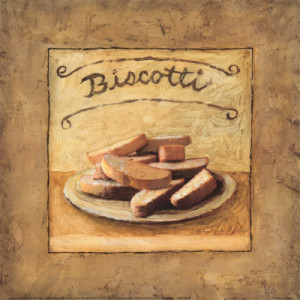Biscotti, From Ancient Tuscany To Contemporary Coffeehouse
Posted on October 21st, 2013 by Anna in Uncategorized | No Comments »
Ask any connoisseur of Italian pastries what the staple Italian dessert is, and they’ll probably say cannoli. But coming in at a close second, a favorite of those who prefer their sweets to be less rich and more crunchy, are biscotti. Originating from the city of Prato, biscotti are twice-baked almond biscuits that date back to the heyday of the Roman Empire, when Pliny the Elder described them as staying edible for centuries. In fact, biscotti were the preferred fare of the Roman Legions, who used to pack them as rations for long military campaigns or wars.
Due to their widespread popularity, biscotti have lasted as a culinary favorite for thousands of years to become a staple shelf-filler at Starbucks worldwide. The appreciation of biscotti saw a resurgence in the 19th century, when the Prato-based pastry chef Antonio Mattei shared his traditional recipe with the rest of the culinary world. An incredibly simple mix of ingredients, without the addition of any milk, oil, or water, biscotti dough consists of flour, sugar, eggs, pine nuts, and raw almonds. The mixture is then baked in a mass on a baking tray, and then, while still hot and soft, cut into slices and baked for a second round until they are lightly browned. This gives the biscotti their signature dry, crunchy texture, making them ideal for dunking in coffee, milk, hot chocolate, tea, or any other beverage. (Although traditionally, in Prato they are taken after dessert with a glass or orange juice, or with a fortified wine called santo vin.)
Although purists may insist on only the simplest of recipes, biscotti have inspired a myriad of variations and similar concoctions throughout the world. For example, my aunt’s own signature brand of biscotti are mixed with cocoa and powdered coffee thrown in, then, once the batch has cooled, each biscotto is dipped into melted chocolate. She also has a recipe where she adds nutmeg and orange zest and then coats the finished product with an orange glaze. Other versions of biscotti can be baked with pistachios, hazelnuts, walnuts, anise, cinnamon, sesame seeds, allspice, vanilla, or virtually any ingredient you can imagine.
The traditional biscotti has gone on to inspire continental pastries and similar desserts in various surrounding countries. In Catalonia they have the carquinyoli, from the French croquignole, which are similar twice-baked, bite-sized cookies with whole almonds thrown into the mix, and are generally served with sweet wines such as moscatell. Valencia has the square-shaped rosegons, which are eaten as a late afternoon snack, generally with strong coffee to break through the sweetness. In Tuscany, the birthplace of biscotti, they have a similar confection called cantuccini, but this is actually a more savory, rustic bread, cooked with olive oil and anise and eaten as an antipasto.
Today biscotti are ubiquitous, and can be found anywhere from Italian delis to supermarkets to local coffeehouses. While there are as many different recipes for biscotti as there are pastry chefs, nothing can beat the classic Tuscan style. With their great flavor, the ease of baking them, and their unbeatable shelf-life, biscotti definitely stand their own among the great pastries of the world.






